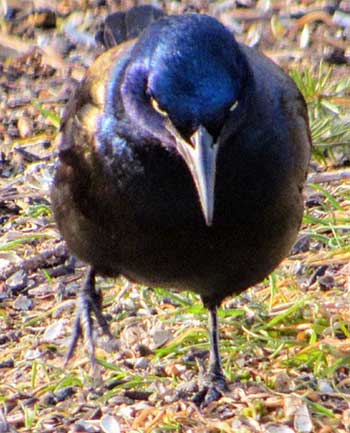 Grackles are large iridescent blackbirds with long legs and tails. They are one of the most abundant breeding birds in North America, nesting in dense colonies with as many as 10 to 30 pairs. In North America, three grackle species occur Common, Great-tailed, and Boat-tailed. All are generally similar in appearance, with males glossy iridescent black and females brownish. Great-tailed and Boat-tailed are more closely related and were once thought to represent the same species. Distinguishing Common Grackle from the others is relatively straight-forward, but separating Great-tailed and Boat-tailed grackles in the field can be more challenging.
Grackles are large iridescent blackbirds with long legs and tails. They are one of the most abundant breeding birds in North America, nesting in dense colonies with as many as 10 to 30 pairs. In North America, three grackle species occur Common, Great-tailed, and Boat-tailed. All are generally similar in appearance, with males glossy iridescent black and females brownish. Great-tailed and Boat-tailed are more closely related and were once thought to represent the same species. Distinguishing Common Grackle from the others is relatively straight-forward, but separating Great-tailed and Boat-tailed grackles in the field can be more challenging.
The Common Grackle, breeding roughly west of the Appalachians and in New England, has a characteristic bronzy back; giving it its name 'Bronzed Grackle'. Birds of the Southeast, from North Carolina to Louisiana, often called the “Florida grackle,” sport a darker green on the back (rather than bronze) and a purple the belly. An intermediate race along the Eastern seaboard is sometimes called the purple grackle.
Grackles are known to be aggressive and ferocious when it comes to defending their nests OR going after your food. In Florida, we see a large number of grackles descend on hotels, restaurants, and resorts, as well as marinas or shipyards. They also cause a fair amount of damage in rural areas with agriculture.
Common Scenarios or Problem Areas
Hotels and Resorts
Hotels and Resorts are often inundated with grackles. They are mostly attracted by food and not afraid to go after what they want. Grackles are determined and will attack humans, adults and children alike. Aside from the physical attacks, grackel droppings, like all bird droppings, present dangers to humans as well: from inhaling parasites to slipping on wet feces.
Marinas and Shipyards
In coastal areas, Marinas and Shipyards also report large flocks of grackles. These are generally Boat-tailed grackles. And again, the birds will aggressively go after scraps of food. The issues with grackles here are similar to those found at hotels and resorts, however, the risk of accidental slipping is greatly increased in a marine environment.
Agricultural Settings
Grackles can also be found in or around agricultural areas, from feedlots to dairy farms, and crop fields. Grackles eat agricultural crops and livestock feed, damage property, spread pathogens, and collide with aircraft.
Grackles Control Methods
Grackles Control is most successful by using a multi-prong approach. We generally recommend a combination of Falconry, Industrial Lasers, and Pyrotechnics.
Falconry
Here, at Hawkeye Bird Control, we offer a proactive falconry program that is both humane and highly effective at controlling pest birds. We use birds of prey as an environmentally friendly way of controlling the behavioural patterns of pest bird species such as grackles, pigeons, gulls, starlings and sparrows.
When dealing with large numbers of pest birds, birds of prey offer faster and longer-lasting results than methods such as killing/shooting. Using Falconry works for controlling birds for many situations including; airport bird strike safety, industrial building infestations/nesting, reducing crop damage from bird feeding, unsanitary areas from excessive bird droppings, landfills, recreational areas and more.
Lasers
Pyrotechnics
Pyrotechnics, as recommended and used by United States Fish and Wildlife Service (FWS) include rope firecrackers, bird bombs, gas cannons (carbide, acetylene), and firearms (.22 caliber rifle, 15 mm pistol, 12-gauge shotgun). Especially in densely populated areas, pyrotechnics are not always feasible.
Hawkeye provides various scaring and exclusion methods to stop the Grackels from landing and nesting that often work best in conjunction.
We are here to help you deal with Pest Bird Control and avoid potential health hazards, costly damage to property, and loss of product and/or productivity if pest birds are not addressed immediately.





